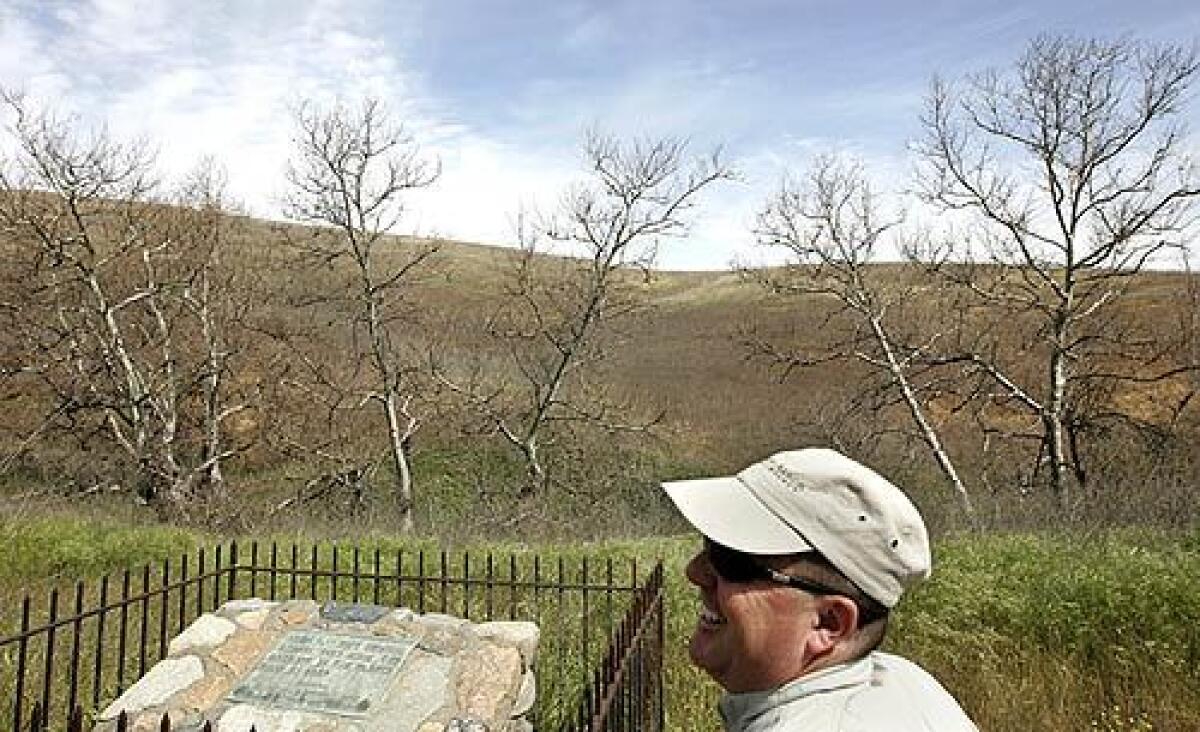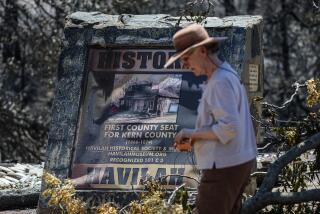Hidden in O.C.’s foothills, a gnarled reminder of California’s past

Wildfires destroy, but they can also reveal. For years, a monument marking the site of one of Orange County’s most infamous killings sat largely obscured amid a thicket of mustard plants a hundred yards or so from the Foothill toll road.
But when the 2007 Santiago fire ripped through the foothills of the Santa Ana Mountains, firefighters discovered something that longtime residents of the rural area and local historians already knew.
People were lynched there.
“Under this tree,” reads a plaque, “General Andres Pico Hung Two Banditos of the Flores Gang in 1857.”
There are seven foreboding old sycamores in the canyon below the tollway, any of which would’ve made a fine impromptu gallows to dispense with the two men in a rage of vigilante justice.
“It didn’t pay to be a bad guy in those days,” said Dave Raetz, director of public programs for the Irvine Ranch Conservancy.
A few months ago the conservancy, which manages thousands of acres of open space in Orange County, began offering docent-led hikes to the Hangman’s Tree marker, erected in 1967 by an equestrian group.
The Orange County lynching of Francisco Ardillero and Juan Catabo by a posse led by the brother of California’s last Mexican governor is a footnote in a larger story of the notorious outlaw Juan Flores. His gang blazed a trail of robbery extending from Los Angeles to San Juan Capistrano before ambushing Los Angeles County Sheriff James Barton, killing him and three other lawmen.
The “Barton Massacre” and the hunt for Flores, who eventually was captured and strung up before several thousand spectators in downtown Los Angeles, became the stuff of legend.
“Immediately after the plank was drawn from under him, the body of Flores swung in the air,” the Los Angeles Star reported. “The fall was too short, and the unfortunate wretch struggled in agony for a considerable time.”
Ardillero and Catabo, their ears cut off and displayed as proof of their deaths, were forgotten.
California was littered with enough hanging trees, both real and rumored, to populate a small forest. Sturdy oaks and sycamores with branches plaintively reaching like outstretched arms were the preferred choice.
Most are long gone -- dead from old age and disease, removed for road-widening projects or simply lost to history.
These living monuments have often been treated with a detached whimsy rather than as sobering reminders of the state’s long history of extrajudicial killing, much of which was fueled by racism.
In 1930 the developers of an upscale Hollywood neighborhood used a sycamore on the property where more than 30 people were hanged as a marketing tool to lure home buyers.
“The dedication of Hollywood’s hangman tree is being held in conjunction with the exhibit of the five Mediterranean model homes,” a story in The Times read. “The tree is located only a short distance from one of the homes.”
Today, the Gold Rush hamlet of Placerville still markets itself to tourists as Old Hangtown. The city’s official logo depicts a miner panning for gold in front of a tree with a noose. (Plans to incorporate the noose in the Police Department’s logo were abandoned, however.) For years, a mannequin hung outside Hangman’s Tree Tavern, beckoning the thirsty.
Most people imagine hangings as “part of a fictionalized past without real people attached to it. It’s nostalgia that stands in for history,” said Ken Gonzales-Day, who wrote “Lynching in the West,” chronicling 350 such cases in California between 1850 and 1935.
Gonzales-Day, 44, is an art professor at Scripps College in Claremont. As part of his research, he sought to photograph hanging trees. Over five years, he shot dozens of trees, creating portraits that are both beautiful and creepy.
The emotional exercise was “part pilgrimage and part memorial,” he said.
“This has been a personal journey. I wanted to see these sites and this history . . . to raise awareness with others about what happened,” he said. “I imagined the trees as witnesses, standing there when the mobs walked by. Someday, they’ll be gone, and the last living pieces of this history will be lost.”
Through the years Orange County’s hanging tree has been routinely misidentified as being along Santiago Canyon Road near the turnoff to Modjeska Canyon. Nearby, a sign on a locked gate proclaims the misnomer “Hangman’s Tree Canyon.”
“Who knows how these things start?” said Mike Boeck, 57, a Irvine Ranch Conservancy docent who has led hikers to the real hanging tree a few miles to the west. “We have a pretty short memory in Southern California.”
The guilty party stands in a lineup with six others. The shrubs that burned in the fire two years ago are coming back all around. If left alone, these non-native plants will again obscure this piece of native history.
Gonzales-Day, who was unaware of the marker, is eager to photograph the scene.
“The hunt continues,” he said.
Docent-led hikes to Orange County’s Hangman’s Tree will be offered later this year after a pair of hawks are done nesting in one of the sycamores.
More to Read
Sign up for Essential California
The most important California stories and recommendations in your inbox every morning.
You may occasionally receive promotional content from the Los Angeles Times.










